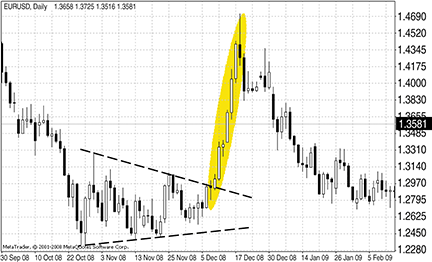CHART PATTERNS
Part 4 Of The Price Model Series
The Thorn At The Bottom
Here’s a reversal pattern that occurs frequently but is difficult to discern during its formation.
The thorn pattern is encountered quite frequently, but it is difficult to discern while it is being formed. Unlike other reversal models, which reflect gradual changes in trend dynamics, the thorn is a sharp jerk of the price in a given direction, immediately followed by a jerk in the opposite direction without any pause. Thorns often appear in low-liquid markets or after a news release.
The reason behind such a situation can be attributed to the psychology of market participants. At a certain time, market participants get overwhelmed with emotions and they trade according to “the greater fool theory” — they pay a lot and hope to meet a greater fool who will pay them even more. It looks like network marketing; the last one who joins the movement loses. All logical calculations made in a quiet room before placing that trade are completely forgotten and irrational decisions come to the forefront.
In the case of a thin market — that is, one with low liquidity — the price movement develops with acceleration, similar to what you see with the Eur/Usd in Figure 1 on December 24, 2008. Looking at the chart, you would think that the situation was beyond control. The market surpassed all conceivable and inconceivable expectations. An experienced trader knows that you need to keep alert during such situations.

Figure 1: a rising thorn. Initially, it looked like a breakout from a triangle. Then the principle of the “greater fool theory” came into play. Prices shot straight up and the appearance of the shooting star marked the end of this vigorous price rally.
Any trader will dream of riding the lead horse during this wild gallop. However, at some moment in the course of a trend development, even the most inexperienced trader may suddenly feel that something is wrong, so a comparison to riding a tiger may be more suitable. It is not enough to catch a tiger and climb it. It is more difficult to dismount the tiger without losing your face and keeping your hands and legs safe and sound.